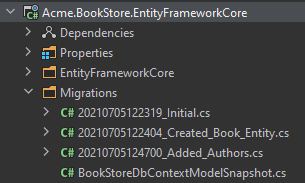Web Application Development Tutorial - Part 7: Authors: Database Integration
Introduction
This part explains how to configure the database integration for the Author entity introduced in the previous part.
DB Context
Open the BookStoreDbContext in the Acme.BookStore.EntityFrameworkCore project and add the following DbSet property:
public DbSet<Author> Authors { get; set; }
Then locate to the OnModelCreating method in BookStoreDbContext class in the same project and add the following lines to the end of the method:
builder.Entity<Author>(b =>
{
b.ToTable(BookStoreConsts.DbTablePrefix + "Authors",
BookStoreConsts.DbSchema);
b.ConfigureByConvention();
b.Property(x => x.Name)
.IsRequired()
.HasMaxLength(AuthorConsts.MaxNameLength);
b.HasIndex(x => x.Name);
});
This is just like done for the Book entity before, so no need to explain again.
Create a new Database Migration
The startup solution is configured to use Entity Framework Core Code First Migrations. Since we've changed the database mapping configuration, we should create a new migration and apply changes to the database.
Open a command-line terminal in the directory of the Acme.BookStore.EntityFrameworkCore project and type the following command:
dotnet ef migrations add Added_Authors
This will add a new migration class to the project:

You can apply changes to the database using the following command, in the same command-line terminal:
dotnet ef database update
If you are using Visual Studio, you may want to use the
Add-Migration Added_AuthorsandUpdate-Databasecommands in the Package Manager Console (PMC). In this case, ensure thatAcme.BookStore.EntityFrameworkCoreis the startup project in Visual Studio andAcme.BookStore.EntityFrameworkCoreis the Default Project in PMC.
Implementing the IAuthorRepository
Create a new class, named EfCoreAuthorRepository inside the Acme.BookStore.EntityFrameworkCore project (in the Authors folder) and paste the following code:
using System;
using System.Collections.Generic;
using System.Linq;
using System.Linq.Dynamic.Core;
using System.Threading.Tasks;
using Acme.BookStore.EntityFrameworkCore;
using Microsoft.EntityFrameworkCore;
using Volo.Abp.Domain.Repositories.EntityFrameworkCore;
using Volo.Abp.EntityFrameworkCore;
namespace Acme.BookStore.Authors;
public class EfCoreAuthorRepository
: EfCoreRepository<BookStoreDbContext, Author, Guid>,
IAuthorRepository
{
public EfCoreAuthorRepository(
IDbContextProvider<BookStoreDbContext> dbContextProvider)
: base(dbContextProvider)
{
}
public async Task<Author> FindByNameAsync(string name)
{
var dbSet = await GetDbSetAsync();
return await dbSet.FirstOrDefaultAsync(author => author.Name == name);
}
public async Task<List<Author>> GetListAsync(
int skipCount,
int maxResultCount,
string sorting,
string filter = null)
{
var dbSet = await GetDbSetAsync();
return await dbSet
.WhereIf(
!filter.IsNullOrWhiteSpace(),
author => author.Name.Contains(filter)
)
.OrderBy(sorting)
.Skip(skipCount)
.Take(maxResultCount)
.ToListAsync();
}
}
- Inherited from the
EfCoreRepository, so it inherits the standard repository method implementations. WhereIfis a shortcut extension method of the ABP. It adds theWherecondition only if the first condition meets (it filters by name, only if the filter was provided). You could do the same yourself, but these type of shortcut methods makes our life easier.sortingcan be a string likeName,Name ASCorName DESC. It is possible by using the System.Linq.Dynamic.Core NuGet package.
See the EF Core Integration document for more information on the EF Core based repositories.


























































